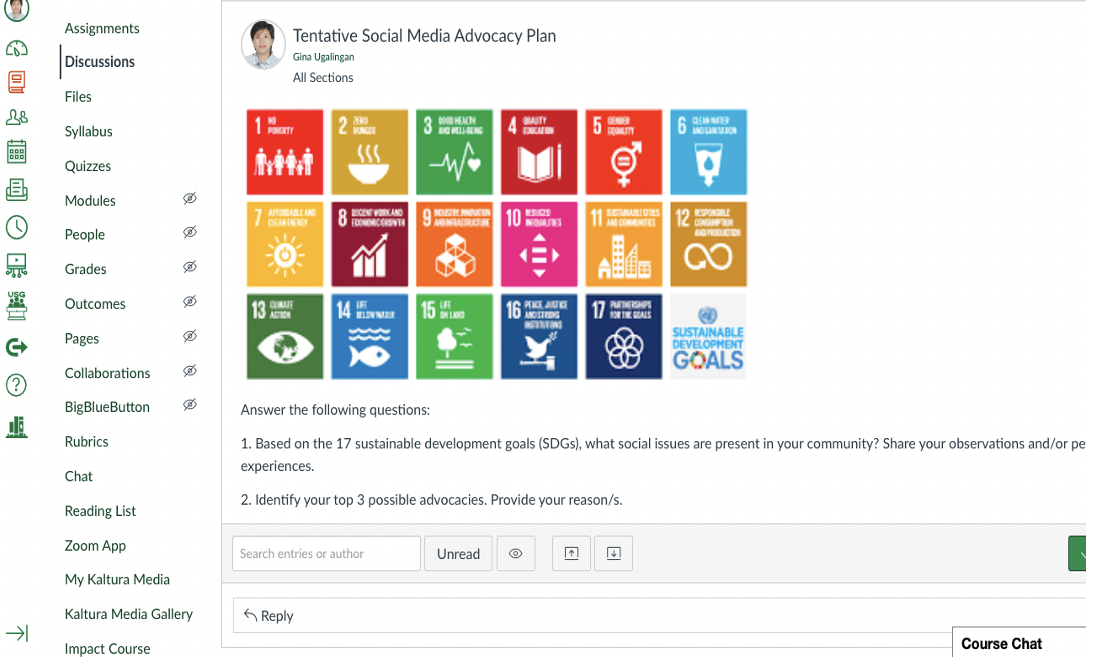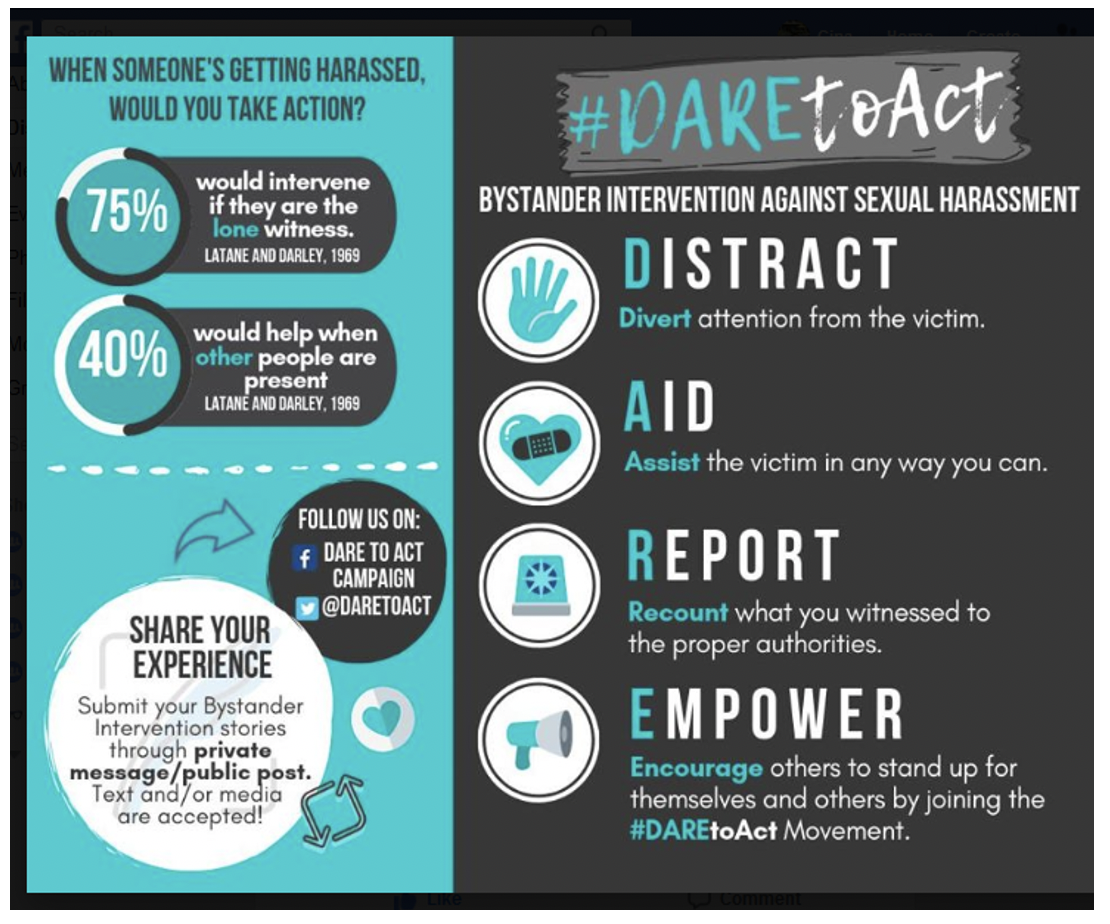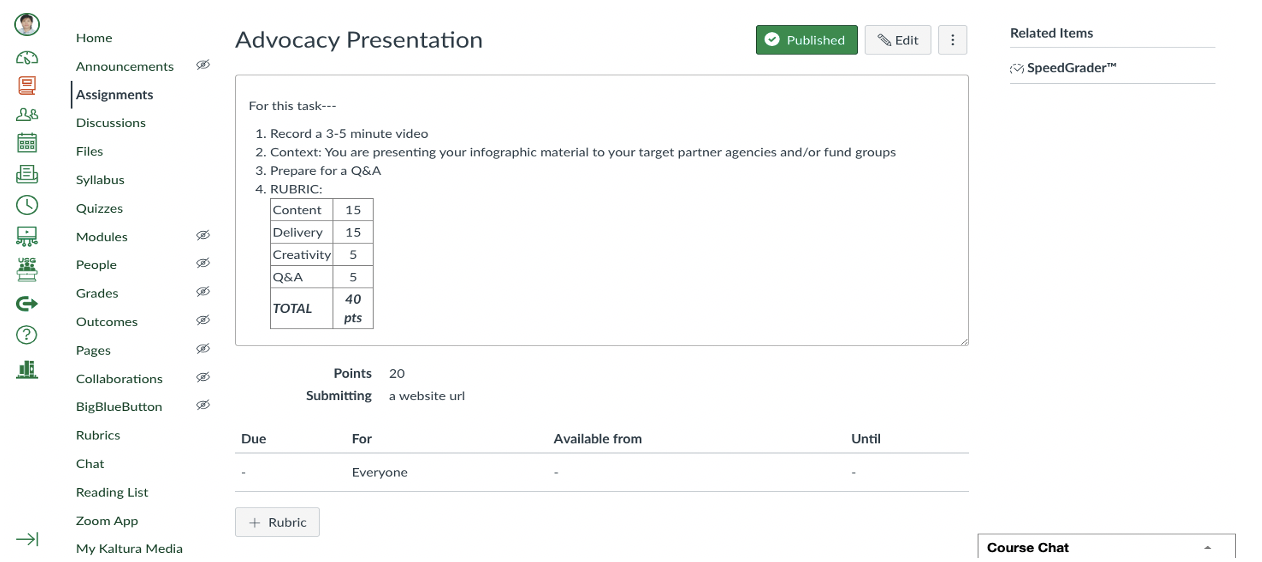Introduction
Awareness of global issues is a significant theme in education as students are taught skills with the aim of developing responsible citizens (Kwee, 2021; Lavrysh et al., 2020; Reeves, 2019; Vasconcelos et al., 2022). In the case of English language courses, global issues lend themselves in interesting ways to allowing students to engage, evaluate and act in the hope that they can contribute to meaningful change. Specifically, since the emergence of the internet as a powerful tool in exchanging information, promoting awareness, and stimulating action, outcomes of English language courses can have a meaningful impact in communities where students belong. For instance, interest groups that advocate to address significant global issues have found a reliable and effective platform to build communities of practice around the world. In 2015, the United Nations (United Nations, 2015) launched the 2030 Agenda for Sustainable Developmentthat aims to transform the world in 15 years by targeting 17 sustainable development goals (SDGs) or global goals. These 17 goals are action plans focused on people, planet, prosperity, peace, and partnership (See Figure 1 below). Different countries and stakeholders have resolved to take part in addressing issues like poverty, hunger and the planet's degradation. As a result, in the effort to make students active members of the community, SDG is now introduced as part of the educational curriculum. For instance, some university courses incorporate SDG as the advocacy platform. Kwee (2021) highlighted the role of teachers’ preparedness to effectively incorporate SDG in the classroom. Using a case-based teaching approach, Vasconcelos et al. (2022) reported that students from four countries were able to have a deeper appreciation of the SDG issues and an opportunity to express their opinions when they were presented real situations (e.g., biodiversity conservation of BIalowieza forest in Poland, preserving the cultural identity of a farm in Portugal). In their study, teachers introduced these real-case issues, and students were expected to discuss and collaborate with their peers and present their arguments and solutions through role-playing or multimodal presentation. Reeves (2019) reported that SDG could be introduced through “co-learning open classes and workshop-style public events” (p. 1389). Rather than the traditional classroom lecture approach, students in this study learned SDGs with the community stakeholders through small group discussions. Moreover, since communication technology bridges geographical distances between participants, interactive tools allow teachers, students, and other stakeholders to collaborate seamlessly (Barros-del Rio et al., 2020; Megawati et al., 2021; Pischetola et al., 2021). In this paper, we describe the implementation of lessons that capitalize on students’ engagement with technology and members of the community to arrive at advocacy plans related to SDGs.
Due to the rise of different global issues such as environmental problems, health concerns, and discrimination, creating advocacy presentations in English language classes can help students engage more meaningfully on concerns that are of significance to the community (Kanemoto et al., 2021; Tan & Mante-Estacio, 2021; Ugalingan et al., 2020). In designing these lessons, we take the position that students are part of a learning community developing knowledge, skills, and attitudes through collaboration with experienced professionals and members of relevant organizations. As such, meaningful and authentic experiences with these members of the community help increase students’ understanding of complex issues tied to the sustainable development goals influencing their development of effective advocacy presentations. Moreover, since online classes provide the necessary tools for collaborative learning, the lessons capitalize on digital literacies which are instrumental in the creation, distribution, and reception of multimodal texts (Frechette, 2014; Ugalingan et al., 2022). Thus, the online lessons incorporate sustainable development goals in developing effective advocacy presentations. Specifically, the lessons aim to equip students with skills in evaluating information, creating accessible and persuasive materials that emphasize the sustainable development goals through collaboration with community members.
The Lessons
Grounded on the community of practice perspective (Lave & Wenger, 1991), the learners are positioned as active yet novice members of the academic community. The lessons are part of the course, Purposive Communication offered to first year university students. Aimed at developing communication skills through a range of interrelated tasks, students are prompted to work through interdisciplinary means to explore social issues and eventually establish advocacy to maximize engagement among members of the community. Specifically, lessons related to the SDGs are implemented to contextualize the social engagement aspect of learning. The three lessons discussed in the present work outline the different stages of preparing advocacy presentations in online ESL classes. Specifically, Lesson 1 focuses on advocacy plan development, Lesson 2 is devoted to the creation of advocacy materials, and Lesson 3 is focused on the advocacy presentation. Moreover, different uses of online tools in achieving the intended goals of the lessons are included. As such, while the lessons are aimed at equipping learners' skills in preparing advocacy presentations, collaboration with the teachers and members of non-government organizations advocating specific SDGs are necessary for the refinement of students’ presentations. In the three lessons, the intended outcome for students is to create an advocacy presentation that emphasizes a specific sustainable development goal.
Lesson 1: Advocacy plan development
Time: 180 minutes
Aims: The students will be able to (1) identify the sustainable development goal of different advocacy presentations from non-governmental organizations, (2) select a specific sustainable goal for their own advocacy project, and (3) write an advocacy plan for their presentation.
Resources/ materials: computer/laptop with internet access, Zoom application, Canvas course platform and Google Docs
Possible problems: Unstable access to the internet, access to Canvas
Procedures
1. Opening
- Inputs on the sustainable development goals are presented through a teacher-led discussion which focuses on the history, development, and implications of the SGDs for local communities.
- In addition, a sample video[1] is presented that provides an overview of the SDGs.
- An alternative is to invite members of non-government organizations (NGOs) in a Zoom conference to discuss their advocacy and projects. Organized as a forum, students are allowed to ask questions on the nature of the advocacy of the invited NGO members.
2. Main Activities
- The students are tasked to participate in a forum online by posting on the Canvas course discussion board. In terms of input, students are expected to identify the SDGs covered in the presentations and relate these inputs to their own observations in their respective communities. Figure 1 shows a sample of a Canvas discussion thread in which the teacher poses questions related to observations of students concerning the SDGs. Further, this solicits inputs from the class on selected advocacy that students intend to work on as part of their advocacy presentation.

Figure 1. Canvas discussion thread
b. In developing the advocacy plan, students are organized into groups to identify a sustainable development goal, conduct research on issues related to the SDG, and formulate an action plan that addresses problems/issues related to the SDG. These are facilitated through a Zoom room meeting with the teacher and Google Docs in order for the groups to brainstorm and develop their advocacy plan.
c. For the advocacy plan, the students will prepare a draft with three parts. The first part is an introduction that contains the rationale for their advocacy based on the selected SDG. Next is the body which contains a tagline, a one-line statement that describes their advocacy and issues/problems observed in the community related to their selected SDG. The third part contains their action plan which covers their strategy in promoting and addressing the issues/problems related to their selected SDG. In order for the students to proceed to the next step, online conferencing with the teacher will be done to refine their drafts.
3. Closing
Since each lesson requires reflective pieces from the input presented and activities done, the teacher presents these questions as writing prompts for students to respond to via online message boards on Canvas. Since students are exploring community issues in relation to identifying their preferred advocacy project, this assignment is done individually.
The students will reflect on their learning activities: What is the relevance of their advocacy in addressing problems/issues in their immediate community? How can their advocacy be best communicated to the community? What problems did they encounter in preparing their advocacy plan and how were these addressed?
Lesson 2: Creation of advocacy materials
Time: 120 minutes
Aims: The students will be able to (1) create advocacy materials in the form of infographic posters, and other materials for their advocacy presentation, and (2) study the language and multimodal requirements in preparing infographic materials.
Resources/ materials: computer/laptop with internet access, Zoom application, Canvas course platform and Canva or other creativity applications
Possible problems: Unstable access to the internet
Procedures
1. Opening
- The teacher provides input through a discussion by presenting different aspects of creating advocacy materials. The discussion should cover aspects of language and multimodal features. For language, input on creating a tagline, using persuasive strategies in presenting advocacy, and making accessible presentations for the audience are covered. For multimodal features, aspects of selecting appropriate fonts, spacing of images and text and condensing information for presentations will be discussed. One example that can be used for the advocacy presentation is infographic materials due to their ease in preparation and distribution online.
- The teacher can provide an example from previous classes to show an ideal example of an infographic that students can refer to. Figure 2 shows a prototypical example used to help students visualize the expected output for the advocacy project.

Figure 2. Sample infographic
2. Main Activities
- Referring to the approved advocacy plan, the students draft their infographic through Canva or other productivity applications. The infographic should contain the tagline of their advocacy, main problems/issues in the community related to their SDG, and potential solutions. They may include pertinent statistics and cases to support their claims.
- Since the infographic materials require approval, peers and the teacher provide feedback in improving the students’ infographic materials.
3. Closing
Given that students are working in teams, the teacher provides a set of questions to each group for reflection. These are answered via online message boards in Canvas. The students reflect on their learning activities: In what ways are advocacy materials consistent with my advocacy plan? In what ways are language and multimodal resources helpful in communicating the main points in my advocacy materials? How has the feedback from my peers and teacher helped me improve my advocacy materials? Is the information provided in my infographic materials accurate and accessible to my audience?
Lesson 3: Advocacy presentation
Time: 120 minutes
Aims: The students will be able to (1) prepare an advocacy presentation based on the approved plan and materials, and (2) participate in an advocacy forum in which they address questions from peers and other stakeholders concerning their advocacy.
Resources/ materials: computer/laptop with internet access, Zoom application, video editing applications
Possible problems: Unstable access to the internet, availability of video editing applications
1. Opening
- The teacher provides guidelines for the advocacy presentation. Depending on the class size, and availability of resources for students and teachers, a set of presentations for the day may be designated. In addition, other guidelines such as the time limit for the presentation, conduct of the question-and-answer portion of the forum, and rubric for evaluation should be discussed. Figure 3 shows a sample rubric used to evaluate the advocacy presentations made by the students.

Figure 3. Sample rubric in Canvas.
- For the advocacy presentation, the students will be tasked to prepare a pre-recorded advocacy presentation that highlights the rationale of the advocacy, the issues, problems, and solutions related to the advocacy.
- If available, stakeholders such as members of the school and NGOs that took part in the first lesson can be invited to provide input on the presentations.
2. Main Activities
- In preparing the videos, the students may opt to use Canva, Prezi, Zoom or Google Meet in preparing their recorded videos
- For the forum, the presentations can be facilitated via Zoom in order to accommodate guests from the school. Since the forum is a formal program, other members of the class can be designated as hosts, moderators, and evaluators.
- Designated presenters should present their video and be ready to address questions from the audience. After all presentations, the host or moderator can provide a synthesis to present the salient points of the presentations.
3. Closing:
Since this lesson is devoted to the advocacy presentation, each group will write a reflective piece via Canvas course online message board pertaining to the activity. The students will reflect on their learning activities: Did the audience find the advocacy presentation accessible? Was the information presented accurate? Was our advocacy presentation persuasive? In what ways did the audience help improve our presentations?
Conclusion
As students participate in different advocacy activities, this allows them to engage in significant issues related to the SDGs. Deeper engagement is made possible through contributions of peers as well as members of NGOs which provide helpful suggestions and insights in improving students’ advocacy presentations. Since the activities were implemented in a communication course, these may be helpful in an EFL/ESL teaching context for three reasons. First, the lessons were designed bearing the community of practice perspective in mind, improvement in selecting information, preparing writing outputs, and delivering presentations are possible through feedback from peers. When students are recognized as novice members of the academic community, representatives of the NGO and the teacher help learners in shaping their work to fit the demands of a specific audience. Second, as online classes require commitment and focus on part of the learners, reflection pieces are necessary for each of the lessons to help them develop strategies in independent learning specifically, the ability to monitor, self-evaluate and improve their performance in each stage of the lessons. Third, because the project is implemented in online English language classes, the activities provide students opportunities to present concise and appealing information. These advocacy presentations feature poignant facts, significant statistics from reliable sources, and realistic actions, this activity allows students to utilize creative skills in presenting information accessible to the audience. In addition, the presentation provides a space for social awareness and engagement. As such, even after the project, students who capture the vision continue to be involved in the advocacy, whether as part of a collective unit or their day-to-day activities, helping them gain a deeper understanding and appreciation of the different sustainable development goals. More importantly, since the output born from the activities are circulated via online spaces, it is necessary that students do not only apply sound principles in designing advocacy materials, but also should keep in the mind that distribution of these on the internet require skills for meaningful engagement.
References
Barros-del Rio, M. A., Mediavilla-Martinez, B., López Nozal, C., & Catarino, F. (2020). Lesson Plan: An interactive digital notepad to upgrade foreign language during practicum. Teaching English with Technology, 20(4), 105-111. https://files.eric.ed.gov/fulltext/EJ1271705.pdf
Frechette, J. D. (2014). Top ten guiding questions for critical digital literacy. Journal of Media Literacy, 61(1&2), 14–21.
Kanemoto, E., Routenberg, R., & Piazza, S. (2021). Semester-long inclusivity project: Using our voices at community engagement. Communication Teacher, 36(1), 38–46. https://doi.org/10.1080/17404622.2021.1895240
Kwee, C. T. T. (2021). I want to teach sustainable development in my English classroom: A case study of incorporating sustainable development goals in English teaching. Sustainability, 13(8). https://doi.org/10.3390/su13084195
Lave, J., & Wenger, E. (1991). Situated learning: Legitimate peripheral participation. Cambridge University Press.
Lavrysh, Y., Lytovchenko, I., & Lukianenko, V. (2020). Ecocomposition integration into ESP course for bachelors at a technical university. MEXTESOL Journal, 44(1). https://www.mextesol.net/journal/index.php?page=journal&id_article=17045
Megawati, F., Mukminatien, N., Permana, A. I., Dewi, L. A., & Fitriati, F. (2021). Emergency remote teaching and learning: Technology-based instructional plan across grade levels. Teaching English with Technology, 21(2), 112-126. https://files.eric.ed.gov/fulltext/EJ1293794.pdf
Pischetola, M., de Miranda, L. V. T., & Albuquerque, P. (2021). The invisible made visible through technologies’ agency: A sociomaterial inquiry on emergency remote teaching in higher education. Learning, Media and Technology, 46(4), 390–403. https://doi.org/10.1080/17439884.2021.1936547
Reeves, A. (2019). Classroom collaborations: Enabling sustainability education via student-community co-learning. International Journal of Sustainability in Higher Education, 20(8), 1376–1392. https://doi.org/10.1108/IJSHE-11-2018-0220
Tan, D. N. L., & Mante-Estacio, M. J. (2021). Reader-text connection: Reporting the engagement of high school students with culturally relevant texts. TEFLIN Journal, 32(2), 342-361. https://doi.org/10.15639/teflinjournal.v32i2/342-361
Ugalingan, G. B., Flores, G. M. L., Garinto, L. A. B., & Mante-Estacio, M. J. (2022). The pedagogy of multiliteracy and multimodality through memes. International Journal of Media and Information Literacy, 7(1), 264-271. https://doi.org/10.13187/ijmil.2022.1.264
Ugalingan, G. B., Valdez, P. N., & Flores, G. M. (2020). Promoting advocacies in an ESL classroom in the Philippines: Insights from an action research project. Journal of Asia TEFL 17(2), 635-642. http://dx.doi.org/10.18823/asiatefl.2020.17.2.21.635
United Nations. (2015). Transforming our world: The 2030 agenda for sustainable development. Department of Economic and Social Affairs: Sustainable Development. https://sdgs.un.org/2030agenda
Vasconcelos, C., Silva, J., Calheiros, C. S. C., Mikusiński, G., Iwińska, K., Skaltsa, I. G., & Krakowska, K. (2022). Teaching sustainable development goals to university students: A cross-country case-based study. Sustainability, 14(3). https://doi.org/10.3390/su14031593
[1] Green, M. (2016). How we can make the world a better place by 2030 [YouTube video]. TED Talks. https://www.youtube.com/watch?v=o08ykAqLOxk

